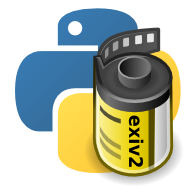Developers¶
If you are a developer and use pyexiv2 in your project, you will find here useful information.
Getting the code¶
pyexiv2’s source code is versioned with bazaar, and all the branches, including the main development focus (sometimes referred to as trunk), are hosted on Launchpad.
To get a working copy of the latest revision of the development branch, just issue the following command in a terminal:
bzr branch lp:pyexiv2
If you need to get a specific revision identified by a tag (all releases of pyexiv2 are tagged), use the following command:
bzr branch -r tag:tag_name lp:pyexiv2
A list of all the available tags can be obtained using the bzr tags command:
osomon@granuja:~/dev/pyexiv2$ bzr tags
release-0.1 60
release-0.1.1 73
release-0.1.2 99
release-0.1.3 99.1.6
release-0.2.0 296
release-0.2.1 306
release-0.2.2 318
release-0.3.0 349
Dependencies¶
You will need the following dependencies installed on your system to build and use pyexiv2:
- Python ≥ 2.6
- boost.python ≥ 1.35
- libexiv2 ≥ 0.19
- SCons
For Python, boost.python and libexiv2, the development files are needed (-dev packages). A typical list of packages to install on a Debian/Ubuntu system is:
python-all-dev libboost-python-dev libexiv2-dev scons
Some unit tests have a dependency on python-tz. This dependency is optional: the corresponding tests will be skipped if it is not present on the system.
Additionally, if you want to cross-compile pyexiv2 for Windows and generate a Windows installer, you will need the following dependencies:
A typical list of packages to install on a Debian/Ubuntu system is:
mingw32 p7zip-full nsis
Building and installing¶
Linux¶
Building pyexiv2 is as simple as invoking scons in the top-level directory:
osomon@granuja:~/dev/pyexiv2$ scons
scons: Reading SConscript files ...
scons: done reading SConscript files.
scons: Building targets ...
g++ -o build/exiv2wrapper.os -c -fPIC -I/usr/include/python2.7 src/exiv2wrapper.cpp
g++ -o build/exiv2wrapper_python.os -c -fPIC -I/usr/include/python2.7 src/exiv2wrapper_python.cpp
g++ -o build/libexiv2python.so -shared build/exiv2wrapper.os build/exiv2wrapper_python.os -lboost_python -lexiv2
scons: done building targets.
The result of the build process is a shared library, libexiv2python.so, in the build directory:
osomon@granuja:~/dev/pyexiv2$ ls build/
exiv2wrapper.os exiv2wrapper_python.os libexiv2python.so
To install pyexiv2 system-wide, just invoke scons install. You will most likely need administrative privileges to proceed. The --user switch will install pyexiv2 in the current user site directory (Python ≥ 2.6 is required).
Note to packagers: if DESTDIR is specified on the command line when invoking scons install, its value will be prepended to each installed target file.
Windows¶
The top-level directory of the development branch contains a shell script named cross-compile.sh that retrieves all the dependencies required and cross-compiles pyexiv2 for Windows on a Linux host. Read the comments in the header of the script to know the pre-requisites.
The result of the compilation is a DLL, libexiv2python.pyd, in the build directory. This file and the pyexiv2 folder in src should be copied to the system-wide site directory of a Python 2.7 setup (typically C:\Python27\Lib\site-packages\) or to the user site directory (%APPDATA%\Python\Python27\site-packages\).
The top-level directory of the branch also contains an NSIS installer script named win32-installer.nsi. From the top-level directory of the branch, run the following command:
makensis win32-installer.nsi
This will generate a ready-to-distribute installer executable named pyexiv2-0.3-setup.exe.
Documentation¶
The present documentation is generated using Sphinx from reStructuredText sources found in the doc/ directory. Invoke scons doc to (re)build the HTML documentation. Alternatively, you can issue the following command:
sphinx-build -b html doc/ doc/_build/
The index of the documentation will then be found under doc/_build/index.html.
Unit tests¶
pyexiv2’s source comes with a battery of unit tests, in the test/ directory. To run them, invoke scons test. Alternatively, you can execute the TestsRunner.py script.
Contributing¶
pyexiv2 is Free Software, meaning that you are encouraged to use it, modify it to suit your needs, contribute back improvements, and redistribute it.
Bugs are tracked on Launchpad. There is a team called pyexiv2-developers open to anyone interested in following development on pyexiv2. Don’t hesitate to subscribe to the team (you don’t need to actually contribute!) and to the associated mailing list.
There are several ways in which you can contribute to improve pyexiv2:
- Use it;
- Give your feedback and discuss issues and feature requests on the mailing list;
- Report bugs, write patches;
- Package it for your favorite distribution/OS.
When reporting a bug, don’t forget to include the following information in the report:
- version of pyexiv2
- version of libexiv2 it was compiled against
- a minimal script that reliably reproduces the issue
- a sample image file with which the bug can reliably be reproduced
